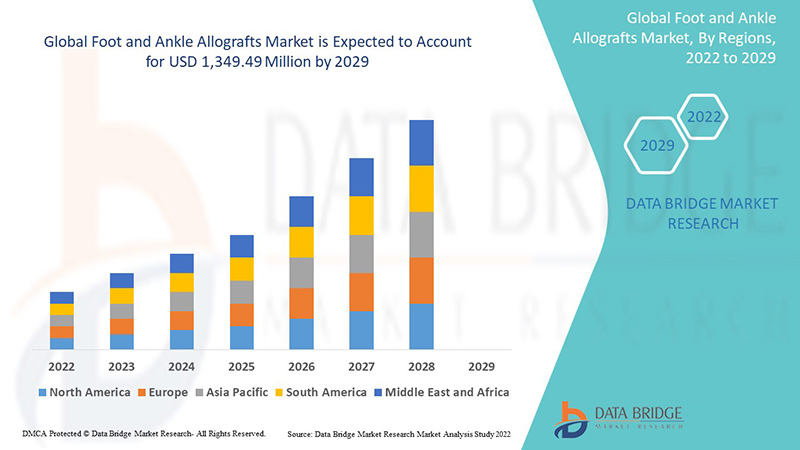
"Executive Summary: Foot and Ankle Allografts Market Size and Share by Application & Industry

Data Bridge Market Research analyses that the market is growing with a CAGR of 9.3% in the forecast period of 2022 to 2029 and is expected to reach USD 1,349.49 million by 2029 from USD 648.05 million in 2021.
The leading Foot and Ankle Allografts Market analysis report is a careful investigation of current scenario of the market and future estimations which spans several market dynamics. This market report presents the best market and business solutions to Foot and Ankle Allografts Market industry in this rapidly revolutionizing market place to thrive in the market. Market definition gives the scope of particular product with respect to the driving factors and restraints in the market. Competitor strategies such as new product launches, expansions, agreements, joint ventures, partnerships, and acquisitions can be utilized well by the Foot and Ankle Allografts Market industry to take better steps for selling goods and services.
Market share analysis and key trend analysis are the key accomplishing factors in Foot and Ankle Allografts Market document. DBMR team provides this market research report with commitment that is promising and the way in which anticipated. This helps to recognize how the market is going to perform in the forecast years by giving information about market definition, classifications, applications, and engagements. Moreover, this global market report puts light on various strategies that are used by key players of the market. By thinking from the customer’s perspective, a team of researchers, forecasters, analysts and industry experts work carefully to formulate Foot and Ankle Allografts Market analysis report.
Discover how the Foot and Ankle Allografts Market is changing with key trends and forecasts. Access the report:
**https://www.databridgemarketresearch.com/reports/global-foot-ankle-allograft-market**
Comprehensive Overview of the Foot and Ankle Allografts Market
By catering to the diverse needs of foot and ankle surgeons and investing in research and development activities, these market players are poised to maintain their competitive edge in the foot and ankle allografts market. The growing demand for innovative treatment options for foot and ankle disorders, coupled with advancements in surgical techniques, is expected to drive market growth in the coming years. Overall, the global foot and ankle allografts market presents lucrative opportunities for both existing and new market players to capitalize on the increasing demand for orthopedic allografts.
The Global Foot and Ankle Allografts Market is witnessing significant growth and evolution driven by the increasing prevalence of foot and ankle-related disorders globally. One of the key trends shaping the market is the shift towards the use of allograft tendons, cartilage, and bones in foot and ankle surgeries due to their superior healing properties and reduced risk of rejection compared to traditional grafts. This trend is expected to continue as healthcare providers and surgeons seek more effective and reliable treatment options for patients with orthopedic conditions.
In terms of market segmentation, the different types of foot and ankle allografts play a crucial role in catering to the specific needs of patients undergoing various surgical procedures. Allograft tendons, cartilage, and bones offer distinct advantages in different clinical scenarios, thereby expanding the scope of treatment options available to healthcare providers. This diversity in allograft types enables surgeons to customize treatment plans based on individual patient needs, leading to better outcomes and patient satisfaction.
Furthermore, the segmentation by end-user highlights the importance of hospitals, ambulatory surgical centers, and specialty clinics in driving the demand for foot and ankle allografts. Hospitals, in particular, emerge as the primary end-users due to the high volume of foot and ankle surgeries performed in these facilities. The increasing awareness about advanced surgical techniques and the emphasis on providing quality healthcare services are expected to further bolster the demand for allografts in hospital settings.
From a geographical perspective, North America continues to lead the global foot and ankle allografts market, propelled by factors such as the high prevalence of orthopedic disorders, presence of established market players, and advanced healthcare infrastructure. However, the Asia-Pacific region is poised for significant growth, driven by the increasing adoption of advanced surgical techniques and the rising incidence of sports injuries and degenerative disorders. This shift towards minimally invasive procedures and the growing healthcare expenditure in emerging markets present lucrative opportunities for market players in the region.
In conclusion, the Global Foot and Ankle Allografts Market is characterized by a dynamic landscape with opportunities for growth and innovation. Key market players are focusing on strategic initiatives to enhance their product portfolios and expand their global footprint. By meeting the evolving needs of foot and ankle surgeons and investing in research and development, these companies are well-positioned to capitalize on the growing demand for orthopedic allografts. Overall, the market presents promising prospects for players to leverage technological advancements and emerging trends to meet the increasing demand for advanced treatment options in foot and ankle surgeries.The Global Foot and Ankle Allografts Market is a dynamic industry driven by the rising prevalence of foot and ankle-related disorders worldwide. The market segmentation based on the type of allografts highlights the importance of tendons, cartilage, and bones in foot and ankle surgeries. Allograft tendons are favored for their excellent healing properties and lower rejection risk, making them a popular choice among surgeons. Allograft cartilage is gaining traction for procedures like osteochondral defect repairs, while allograft bones are crucial for fractures and fusion procedures in the foot and ankle region. This diverse range of allograft types allows for tailored treatment approaches, enhancing patient outcomes and satisfaction.
The segmentation by end-users underscores the significant role of hospitals, ambulatory surgical centers, and specialty clinics in driving the demand for foot and ankle allografts. Hospitals, being the primary end-users, witness a high volume of foot and ankle surgeries, emphasizing the need for quality allograft products in such settings. The global market players are strategically positioning themselves to cater to the specific needs of foot and ankle surgeons while also investing in research and development to introduce innovative treatment options for orthopedic conditions.